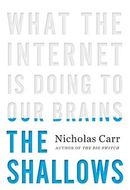Dr. Gary Ackerman reviewed The shallows by Nicholas Carr
The Shallows
4 stars
Between 2008 and 2011, I wrote several brief reviews of books which appeared on the Education Review web site. Since then, the editors ceased publication of that type of review and removed the previously published brief reviews from the site. I am making the original drafts of my reviews available here.
Brief Review of Carr, N. (2010). The shallows: What the Internet is doing to our brains. New York: W. W. Norton & Company. By Dr. Gary L. Ackerman, January 2011
The Shallows book coverNicholas Carr is a well-known writer on science topics, in recent years, the focus of his books has been information technology and its influences on human organizations and society. In this book, Carr turns his attention to the Internet and the manner in which online information is presented, and the influences of that infosphere on human cognition. Although not intended specifically for educators, the book does …
Between 2008 and 2011, I wrote several brief reviews of books which appeared on the Education Review web site. Since then, the editors ceased publication of that type of review and removed the previously published brief reviews from the site. I am making the original drafts of my reviews available here.
Brief Review of Carr, N. (2010). The shallows: What the Internet is doing to our brains. New York: W. W. Norton & Company. By Dr. Gary L. Ackerman, January 2011
The Shallows book coverNicholas Carr is a well-known writer on science topics, in recent years, the focus of his books has been information technology and its influences on human organizations and society. In this book, Carr turns his attention to the Internet and the manner in which online information is presented, and the influences of that infosphere on human cognition. Although not intended specifically for educators, the book does have potential to influence stakeholders’ thinking about the future of education and the popular dialogue about education in the media-rich world.
Carr reviews much well-known research in fields such as media theory, computer science, and cognitive science and he both puts the research in historical context and discusses the implications of that research for explaining phenomena we observer in our students, ourselves, and society today. His reviews are brief, lacking some detail, but very appropriate for a 200-page book written for general audiences. He does provide both references and a bibliography for those who seek more details on these ideas.
Throughout the chapters in which Carr establishes the facts of the effects of networked information on society and on individuals, the tone is very neutral. One senses Carr is about to conclude that the Internet is exerting terrible effects on humans, and end with a Luddite rant; and then within a few pages one senses Carr is about to conclude that the Internet is a great benefit to human cognition. He draws neither conclusion too early, simply reviews the evidence for how the current observations related to information technology are similar to observations as information technologies emerged in the historic past and explains the science explaining those observations.
In the last two chapters, however, Carr suggests that the Internet is exerting influences that may not be for the benefit of humankind, although he maintains his matter-of-fact style. Carr posits that when humans adopt any technology, the result is a separation between humans and the nature that is controlled via the technology. Carr does not argue for avoiding the Internet, but he does argue for using it support human thinking and learning. He argues for turning it off to allow for deep thinking, and to literally getting outside and relax your brain. It seems good advice for educators charged with designing curriculum and delivering instruction.

